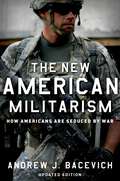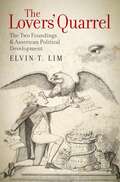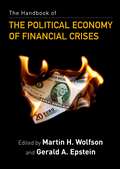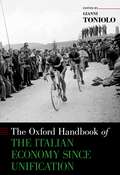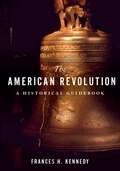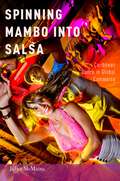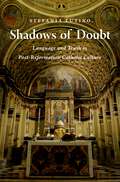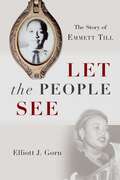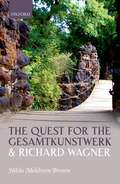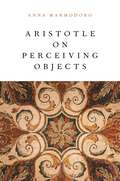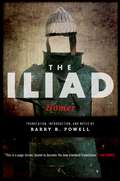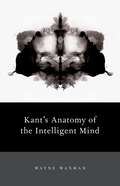- Table View
- List View
Two Nations Indivisible: Mexico, the United States, and the Road Ahead
by Shannon K. O'NeilFive freshly decapitated human heads are thrown onto a crowded dance floor in western Mexico. A Mexican drug cartel dismembers the body of a rival and then stitches his face onto a soccer ball. These are the sorts of grisly tales that dominate the media, infiltrate movies and TV shows, and ultimately shape Americans' perception of Mexico as a dangerous and scary place, overrun by brutal drug lords. Without a doubt, the drug war is real. In the last six years, over 60,000 people have been murdered in narco-related crimes. But, there is far more to Mexico's story than this gruesome narrative would suggest. While thugs have been grabbing the headlines, Mexico has undergone an unprecedented and under-publicized political, economic, and social transformation. In her groundbreaking book, Two Nations Indivisible, Shannon K. O'Neil argues that the United States is making a grave mistake by focusing on the politics of antagonism toward Mexico. Rather, we should wake up to the revolution of prosperity now unfolding there. The news that isn't being reported is that, over the last decade, Mexico has become a real democracy, providing its citizens a greater voice and opportunities to succeed on their own side of the border. Armed with higher levels of education, upwardly-mobile men and women have been working their way out of poverty, building the largest, most stable middle class in Mexico's history. This is the Mexico Americans need to get to know. Now more than ever, the two countries are indivisible. It is past time for the U.S. to forge a new relationship with its southern neighbor. Because in no uncertain terms, our future depends on it.
The New American Militarism: How Americans Are Seduced by War
by Andrew J. BacevichIn this provocative book, Andrew Bacevich warns of a dangerous dual obsession that has taken hold of Americans, both conservatives and liberals alike. It is a marriage of militarism and utopian ideology, of unprecedented military might wed to a blind faith in the universality of American values. This mindset, Bacevich warns, invites endless war and the ever-deepening militarization of U.S. policy. It promises not to perfect but to pervert American ideals and to accelerate the hollowing out of American democracy. In The New American Militarism, Bacevich examines the origins and implications of this misguided enterprise. He shows how American militarism emerged as a reaction to the Vietnam War, when various groups in American society -soldiers, politicians on the make, intellectuals, strategists, Christian evangelicals, even purveyors of pop culture-came to see the revival of military power and the celebration of military values as the antidote to all the ills besetting the country as a consequence of Vietnam and the 1960s. The upshot, acutely evident in the aftermath of 9/11, has been a revival of vast ambitions, this time coupled with a pronounced affinity for the sword. Bacevich urges Americans to restore a sense of realism and a sense of proportion to U.S. policy. He proposes, in short, to bring American purposes and American methods-especially with regard to the role of the military-back into harmony with the nation's founding ideals. For this edition, Bacevich has written a new Afterword in which he considers how American militarism has changed in the past five years. He explores in particular how this ideology has functioned under Barack Obama, who ran for president on a campaign based on hope for change and for a new beginning. Despite such rhetoric, Bacevich powerfully suggests, the attitudes and arrangements giving rise to the new American militarism remain intact and inviolable as ever.
The Silk Road: A Very Short Introduction (Very Short Introductions)
by James A. MillwardThe phrase "silk road" evokes vivid scenes of merchants leading camel caravans across vast stretches to trade exotic goods in glittering Oriental bazaars, of pilgrims braving bandits and frozen mountain passes to spread their faith across Asia. Looking at the reality behind these images, this Very Short Introduction illuminates the historical background against which the silk road flourished, shedding light on the importance of old-world cultural exchange to Eurasian and world history. On the one hand, historian James A. Millward treats the silk road broadly, to stand in for the cross-cultural communication between peoples across the Eurasian continent since at least the Neolithic era. On the other, he highlights specific examples of goods and ideas exchanged between the Mediterranean, Persia, India, and China, along with the significance of these exchanges. While including silks, spices, and travelers' tales of colorful locales, the book explains the dynamics of Central Eurasian history that promoted Silk Road interactions--especially the role of nomad empires--highlighting the importance of the biological, technological, artistic, intellectual, and religious interchanges across the continent. Millward shows that these exchanges had a profound effect on the old world that was akin to, if not on the scale of, modern globalization. He also disputes the idea that the silk road declined after the collapse of the Mongol empire or the opening of direct sea routes from Europe to Asia, showing how silk road phenomena continued through the early modern and modern expansion of the Russian and Chinese states across Central Asia. Millward concludes that the idea of the silk road has remained powerful, not only as a popular name for boutiques and restaurants, but also in modern politics and diplomacy, such as U.S. Secretary of State Hilary Clinton's "Silk Road Initiative" for India, Pakistan, and Afghanistan.
The Lovers' Quarrel: The Two Foundings and American Political Development
by Elvin T. LimThe United States has had not one, but two Foundings. The Constitution produced by the Second Founding came to be only after a vociferous battle between Federalists and Anti-Federalists. The Federalists favored a relatively powerful central government, while the Anti-Federalists distrusted the concentration of power in one place and advocated the preservation of sovereignty in the states as crucibles of post-revolutionary republicanism -- the legacy of the First Founding. This philosophical cleavage has been at the heart of practically every major political conflict in U.S. history, and lives on today in debates between modern liberals and conservatives. In The Lovers' Quarrel, Elvin T. Lim presents a systematic and innovative analysis of this perennial struggle. The framers of the second Constitution, the Federalists, were not operating in an ideational or institutional vacuum; rather, the document they drafted and ratified was designed to remedy the perceived flaws of the Articles of Confederation and Perpetual Union. To decouple the Two Foundings is to appreciate that there is no such thing as "original meaning," only original dissent. Because the Anti-Federalists insisted that prior and democratically sanctioned understandings of federalism and union had to be negotiated and partially grafted onto the new Constitution, the Constitution's Articles and the Bill of Rights do not cohere as well together as has conventionally been thought. Rather, they represent two antithetical orientations toward power, liberty, and republicanism. The altercation over the necessity of the Second Founding generated coherent and self-contained philosophies that would become the core of American political thought, reproduced and transmitted across two centuries, whether the victors were the neo-Federalists (such as during the Civil War and the New Deal) or the neo-Anti-Federalists (such as during the Jacksonian era and the Reagan Revolution). The Second Founding -- the sole "founding" that we generally speak of -- would become a template for the unique, prototypically American species of politics and political debate. Because of it, American political development occurs only after the political entrepreneurs of each generation lock horns in a Lovers' Quarrel about the principles of one of the Two Foundings, and succeed in justifying and forging a durable expansion or contraction of federal authority.
Making the American Century: Essays on the Political Culture of Twentieth Century America
by Bruce J. SchulmanThe twentieth century has been popularly seen as "the American Century," a long period in which the United States had amassed the economic resources, the political and military strength, and the moral prestige to assume global leadership. By century's end, the trajectory of American politics, the sense of ever waxing federal power, and the nation's place in the world seemed less assured. Americans of many stripes came to contest the standard narratives of nation building and international hegemony charted by generations of historians. In this volume, a group of distinguished U.S. historians confronts the teleological view of the inexorable transformation of the United States into a modern nation. The contributors analyze a host of ways in which local places were drawn into a wider polity and culture, while at the same time revealing how national and international structures and ideas created new kinds of local movements and local energies. Rather than seeing the century as a series of conflicts between liberalism and conservatism, they illustrate the ways in which each of these political forces shaped its efforts over the other's cumulative achievements, accommodating to shifts in government, social mores, and popular culture. They demonstrate that international connections have transformed domestic life in myriad ways and, in turn, that the American presence in the world has been shaped by its distinctive domestic political culture. Finally, they break down boundaries between the public and private sectors, showcasing the government's role in private life and how private organizations influenced national politics. Revisiting and revising many of the chestnuts of American political history, this volume challenges received wisdom about the twentieth-century American experience.
Manifesting America: The Imperial Construction of U.S. National Space
by Mark RifkinManifesting America explores how Native American and Mexican American writers use various kinds of nonfiction to challenge the ideology of manifest destiny.
Processing the Past: Contesting Authority in History and the Archives (Oxford Series on History and Archives)
by William G. Rosenberg Francis X. Blouin Jr.Processing the Past explores the dramatic changes taking place in historical understanding and archival management, and hence the relations between historians and archivists. Written by an archivist and a historian, it shows how these changes have been brought on by new historical thinking, new conceptions of archives, changing notions of historical authority, modifications in archival practices, and new information technologies. The book takes an "archival turn" by situating archives as subjects rather than places of study, and examining the increasingly problematic relationships between historical and archival work. By showing how nineteenth- and early twentieth-century historians and archivists in Europe and North America came to occupy the same conceptual and methodological space, the book sets the background to these changes. In the past, authoritative history was based on authoritative archives and mutual understandings of scientific research. These connections changed as historians began to ask questions not easily answered by traditional documentation, and archivists began to confront an unmanageable increase in the amount of material they processed and the challenges of new electronic technologies. The authors contend that historians and archivists have divided into two entirely separate professions with distinct conceptual frameworks, training, and purposes, as well as different understandings of the authorities that govern their work. Processing the Past moves toward bridging this divide by speaking in one voice to these very different audiences. Blouin and Rosenberg conclude by raising the worrisome question of what future historical archives might be like if historical scholars and archivists no longer understand each other, and indeed, whether their now different notions of what is archival and historical will ever again be joined.
The Oxford Handbook of the American Revolution (Oxford Handbooks)
by Jane Kamensky Edward G. GrayThe Oxford Handbook of the American Revolution draws on a wealth of new scholarship to create a vibrant dialogue among varied approaches to the revolution that made the United States. In thirty-three essays written by authorities on the period, the Handbook brings to life the diverse multitudes of colonial North America and their extraordinary struggles before, during, and after the eight-year-long civil war that secured the independence of thirteen rebel colonies from their erstwhile colonial parent. The chapters explore battles and diplomacy, economics and finance, law and culture, politics and society, gender, race, and religion. Its diverse cast of characters includes ordinary farmers and artisans, free and enslaved African Americans, Indians, and British and American statesmen and military leaders. In addition to expanding the Revolution's who, the Handbook broadens its where, portraying an event that far transcended the boundaries of what was to become the United States. It offers readers an American Revolution whose impact ranged far beyond the thirteen colonies. The Handbook's range of interpretive and methodological approaches captures the full scope of current revolutionary-era scholarship. Its authors, British and American scholars spanning several generations, include social, cultural, military, and imperial historians, as well as those who study politics, diplomacy, literature, gender, and sexuality. Together and separately, these essays demonstrate that the American Revolution remains a vibrant and inviting a subject of inquiry. Nothing comparable has been published in decades.
The Handbook of the Political Economy of Financial Crises
by Martin H. WolfsonThe Great Financial Crisis that began in 2007 reminds us with devastating force that financial instability and crises are endemic to capitalist economies, and that it is only strong and dynamically-changing financial regulations that can keep the damage caused by these crises within bounds. The international financial system and individual national economies, including that of the United States, are suffering from the aftermath of the worst financial crisis since the Great Depression. Economists are struggling to understand the origins and implications of the crisis. The Handbook of the Political Economy of Financial Crises uses a political economy theoretical framework to analyze the crisis. After an opening chapter that describes the dimensions of the current crisis, the next section provides relevant theoretical frameworks. Subsequent sections apply these theoretical frameworks to analyze the background, dimensions, and implications of the crisis for the world economy. Leading scholars push forward our understanding of how and why our international and domestic economies are susceptible to financial breakdown and what can be done to mitigate this problem in the future. The methodology throughout applies theoretical concepts in the context of an historical and institutional understanding of the real world. By emphasizing the historical and institutional aspects of financial crises, the authors advance economic knowledge and provide insights into how we can manage our financial system to improve the lives of ordinary people.
Vital Crises in Italian Cinema: Iconography, Stylistics, Politics
by P. Adams SitneyExamining the landmark works that ushered in Italy's golden age of cinema, P. Adams Sitney provides a stylish, historically rich survey of the epochal films made by Roberto Rossellini, Vittorio De Sica, Luchino Visconti, Federico Fellini, Michelangelo Antonioni, and others in the years after World War II. Remarking on the period in 1957, Pier Paolo Pasolini wrote that its films reflected a "vital crisis" in Italian culture after the fall of Fascism. Sitney expands this conceit to demonstrate the multivalent social and political forces behind a range of movies made from the mid-1940s through the1960s that includes Paisa, La terra trema, Ladri di biciclette, L'Avventura, and La dolce vita. Throughout its pages, the book considers how the nation's cinema depicts the convergence of Christian and Resistance iconography; contemplates the debate over dialect and a national language; deploys cinematic effects for the purposes of political allegory; and incorporates insights from the psychoanalytic discourse that became popular in Italy during the fifties and sixties. This new edition includes an epilogue that extends the range of the study into the 1970s with discussions of Nanni Moretti's Io sono autaurchico, the Tavianis' Padre Padrone, and Ermanno Olmi's L'albero degli zoccoli.
The Oxford Handbook of the Italian Economy Since Unification (Oxford Handbooks)
by Gianni TonioloThis Oxford Handbook provides a fresh overall view and interpretation of the modern economic growth of one of the largest European countries, whose economic history is less known internationally than that of other comparably large and successful economies. It will provide, for the first time, a comprehensive, quantitative "new economic history" of Italy. The handbook offers an interpretation of the main successes and failures of the Italian economy at a macro level, the research--conducted by a large international team of scholars --contains entirely new quantitative results and interpretations, spanning the entire 150-year period since the unification of Italy, on a large number of issues. By providing a comprehensive view of the successes and failures of Italian firms, workers, and policy makers in responding to the challenges of the international business cycle, the book crucially shapes relevant questions on the reasons for the current unsatisfactory response of the Italian economy to the ongoing "second globalization." Most chapters of the handbook are co-authored by both an Italian and a foreign scholar.
The American Revolution: A Historical Guidebook
by Frances H. KennedyIn 1996, Congress commissioned the National Park Service to compile a list of sites and landmarks connected with the American Revolution that it deemed vital to preserve for future generations. Some of these sites are well known--Bunker Hill, Valley Forge, Fort Ticonderoga--and in no danger of being lost; others less so-- Blackstock's Plantation in South Carolina or Bryan's Station in Kentucky--and more vulnerable. But all are central to the story of our nation's fight for independence. From battlefields to encampments, meeting houses to museums, these places offer us a chance to rediscover the remarkable men and women who founded this nation and to recognize the relevance of not just what they did, but where they did it. The American Revolution: A Historical Guidebook takes readers to nearly 150 of these sites, providing an overview of the Revolution through an exploration of the places where American independence was articulated, fought for, and eventually secured. Beginning with the Boston Common, first occupied by British troops in 1768, and closing with Fraunces Tavern in New York, where George Washington bid farewell to his officers on December 4, 1783, Kennedy takes readers on a tour of the most significant places of Revolutionary history. Accompanied by illuminating excerpts and essays from some of the foremost scholars in the field, including David McCullough, Barbara Tuchman, David Hackett Fischer, Eric Foner, and John Ferling, the entries move in a roughly chronological order from the pre-Revolutionary years up through 1787. Taken together, the combination of site, essay, and excerpt provides rich context and overview, giving a sense of the major figures and events as well as the course of the Revolution, and cover topics ranging from the Boston Tea Party to the frontier wars. The guide is encyclopedic in scope and covers a wide geographical sweep. Accompanied by historical maps, as well as a number of illuminating primary documents including the Declaration of Independence and letters from John Adams and George Washington, it offers a comprehensive picture of how the Revolutionary War unfolded on American soil, and also points readers to the best writing on the subject in the last fifty years. The American Revolution: A Historical Guidebook is an essential companion for anyone interested in the story and history of our nation's founding.
The American Revolution: A Historical Guidebook
by Frances H. KennedyIn 1996, Congress commissioned the National Park Service to compile a list of sites and landmarks connected with the American Revolution that it deemed vital to preserve for future generations. Some of these sites are well known--Bunker Hill, Valley Forge, Fort Ticonderoga--and in no danger of being lost; others less so-- Blackstock's Plantation in South Carolina or Bryan's Station in Kentucky--and more vulnerable. But all are central to the story of our nation's fight for independence. From battlefields to encampments, meeting houses to museums, these places offer us a chance to rediscover the remarkable men and women who founded this nation and to recognize the relevance of not just what they did, but where they did it. The American Revolution: A Historical Guidebook takes readers to nearly 150 of these sites, providing an overview of the Revolution through an exploration of the places where American independence was articulated, fought for, and eventually secured. Beginning with the Boston Common, first occupied by British troops in 1768, and closing with Fraunces Tavern in New York, where George Washington bid farewell to his officers on December 4, 1783, Kennedy takes readers on a tour of the most significant places of Revolutionary history. Accompanied by illuminating excerpts and essays from some of the foremost scholars in the field, including David McCullough, Barbara Tuchman, David Hackett Fischer, Eric Foner, and John Ferling, the entries move in a roughly chronological order from the pre-Revolutionary years up through 1787. Taken together, the combination of site, essay, and excerpt provides rich context and overview, giving a sense of the major figures and events as well as the course of the Revolution, and cover topics ranging from the Boston Tea Party to the frontier wars. The guide is encyclopedic in scope and covers a wide geographical sweep. Accompanied by historical maps, as well as a number of illuminating primary documents including the Declaration of Independence and letters from John Adams and George Washington, it offers a comprehensive picture of how the Revolutionary War unfolded on American soil, and also points readers to the best writing on the subject in the last fifty years. The American Revolution: A Historical Guidebook is an essential companion for anyone interested in the story and history of our nation's founding.
Spinning Mambo into Salsa: Caribbean Dance in Global Commerce
by Juliet McMainsArguably the world's most popular partnered social dance form, salsa's significance extends well beyond the Latino communities which gave birth to it. The growing international and cross-cultural appeal of this Latin dance form, which celebrates its mixed origins in the Caribbean and in Spanish Harlem, offers a rich site for examining issues of cultural hybridity and commodification in the context of global migration. Salsa consists of countless dance dialects enjoyed by varied communities in different locales. In short, there is not one dance called salsa, but many. Spinning Mambo into Salsa, a history of salsa dance, focuses on its evolution in three major hubs for international commercial export-New York, Los Angeles, and Miami. The book examines how commercialized salsa dance in the 1990s departed from earlier practices of Latin dance, especially 1950s mambo. Topics covered include generational differences between Palladium Era mambo and modern salsa; mid-century antecedents to modern salsa in Cuba and Puerto Rico; tension between salsa as commercial vs. cultural practice; regional differences in New York, Los Angeles, and Miami; the role of the Web in salsa commerce; and adaptations of social Latin dance for stage performance. Throughout the book, salsa dance history is linked to histories of salsa music, exposing how increased separation of the dance from its musical inspiration has precipitated major shifts in Latin dance practice. As a whole, the book dispels the belief that one version is more authentic than another by showing how competing styles came into existence and contention. Based on over 100 oral history interviews, archival research, ethnographic participant observation, and analysis of Web content and commerce, the book is rich with quotes from practitioners and detailed movement description.
SPINNING MAMBO INTO SALSA C: Caribbean Dance in Global Commerce
by Juliet McMainsArguably the world's most popular partnered social dance form, salsa's significance extends well beyond the Latino communities which gave birth to it. The growing international and cross-cultural appeal of this Latin dance form, which celebrates its mixed origins in the Caribbean and in Spanish Harlem, offers a rich site for examining issues of cultural hybridity and commodification in the context of global migration. Salsa consists of countless dance dialects enjoyed by varied communities in different locales. In short, there is not one dance called salsa, but many. Spinning Mambo into Salsa, a history of salsa dance, focuses on its evolution in three major hubs for international commercial export-New York, Los Angeles, and Miami. The book examines how commercialized salsa dance in the 1990s departed from earlier practices of Latin dance, especially 1950s mambo. Topics covered include generational differences between Palladium Era mambo and modern salsa; mid-century antecedents to modern salsa in Cuba and Puerto Rico; tension between salsa as commercial vs. cultural practice; regional differences in New York, Los Angeles, and Miami; the role of the Web in salsa commerce; and adaptations of social Latin dance for stage performance. Throughout the book, salsa dance history is linked to histories of salsa music, exposing how increased separation of the dance from its musical inspiration has precipitated major shifts in Latin dance practice. As a whole, the book dispels the belief that one version is more authentic than another by showing how competing styles came into existence and contention. Based on over 100 oral history interviews, archival research, ethnographic participant observation, and analysis of Web content and commerce, the book is rich with quotes from practitioners and detailed movement description.
Clitophon's Challenge: Dialectic in Plato's Meno, Phaedo, and Republic
by Hugh H. BensonHugh H. Benson explores Plato's answer to Clitophon's challenge, the question of how one can acquire the knowledge Socrates argues is essential to human flourishing-knowledge we all seem to lack. Plato suggests two methods by which this knowledge may be gained: the first is learning from those who already have the knowledge one seeks, and the second is discovering the knowledge one seeks on one's own. The book begins with a brief look at some of the Socratic dialogues where Plato appears to recommend the former approach while simultaneously indicating various difficulties in pursuing it. The remainder of the book focuses on Plato's recommendation in some of his most important and central dialogues-the Meno, Phaedo, and Republic-for carrying out the second approach: de novo inquiry. The book turns first to the famous paradox concerning the possibility of such an inquiry and explores Plato's apparent solution. Having defended the possibility of de novo inquiry as a response to Clitophon's challenge, Plato explains the method or procedure by which such inquiry is to be carried out. The book defends the controversial thesis that the method of hypothesis, as described and practiced in the Meno, Phaedo, and Republic, is, when practiced correctly, Plato's recommended method of acquiring on one's own the essential knowledge we lack. The method of hypothesis when practiced correctly is, then, Platonic dialectic, and this is Plato's response to Clitophon's challenge. "This is a new book on a critically important topic, methodology, as it is explored in three of the most important works by one of the most important philosophers in the very long history of philosophy, written by a scholar of international stature who is working from many years of experience and currently at the top of his game. It promises to be one of the most important books ever written on this subject."-Nicholas Smith, James F. Miller Professor of Humanities, Lewis and Clark College "The thesis is bold and the results are important for our understanding of some of the most studied and controversial dialogues by and philosophical theses in Plato. In my view, Hugh Benson's examination of the method of hypothesis in the Meno and the Phaedo is a tour de force of subtle and careful scholarship: I think that this part of the book will be adopted as the standard interpretation of this basic notion in Plato. An excellent and important book."-Charles Brittain, Susan Linn Sage Professor of Philosophy and Humane Letters, Cornell University
Shadows of Doubt: Language and Truth in Post-Reformation Catholic Culture
by Stefania TutinoNamed a Book of the Year by History Today In a compelling examination of the hermeneutical and epistemological anxieties gripping both the early modern and our current world, Stefania Tutino shows that post-Reformation Catholicism did not simply usher in modernity, but postmodernity as well. This deft study provides new insight into and a fresh perspective on the context of the Protestant Reformation and the Catholic response to it. Shadows of Doubt provides a collection of case-studies centered on the relationship between language, the truth of men, and the Truth of theology. Most of these case-studies illuminate little-known figures in the history of early modern Catholicism. While the militant aspects of post-Tridentine Catholicism can be appreciated by studying figures such as Robert Bellarmine or Cesare Baronio, who were the solid pillars of the intellectual and theological structure of the Church of Rome, an understanding of the more fragile and shadowy aspects of early modernity requires an exploration of the demimonde of post-Reformation Catholicism. Tutino examines the thinkers whom few scholars mention and fewer read, demonstrating that post-Reformation Catholicism was not simply a world of solid certainties to be opposed to the Protestant falsehoods, but also a world in which the stable Truth of theology existed alongside and contributed to a number of far less stable truths concerning the world of men. Post-Reformation Catholic culture was not only concerned with articulating and affirming absolute truths, but also with exploring and negotiating the complex links between certainty and uncertainty. By bringing to light this fascinating and hitherto largely unexamined side of post-Tridentine Catholicism, Tutino reveals that post-Reformation Catholic culture was a vibrant laboratory for many of the issues that we face today: it was a world of fractures and fractured truths which we, with a heightened sensitivity to discrepancies and discontinuities, are now well-suited to understand.
Let the People See: The Story of Emmett Till
by Elliott J. GornThe world knows the story of young Emmett Till. In August 1955, the fourteen-year-old Chicago boy supposedly flirted with a white woman named Carolyn Bryant, who worked behind the counter of a country store, while visiting family in Mississippi. Three days later, his mangled body was recovered in the Tallahatchie River, weighed down by a cotton-gin fan. Till's killers, Bryant's husband and his half-brother, were eventually acquitted on technicalities by an all-white jury despite overwhelming evidence. It seemed another case of Southern justice. Then details of what had happened to Till became public, which they did in part because Emmett's mother, Mamie Till-Mobley, insisted that his casket remain open during his funeral. The world saw the horror, and Till's story gripped the country and sparked outrage. Black journalists drove down to Mississippi and risked their lives interviewing townsfolk, encouraging witnesses, spiriting those in danger out of the region, and above all keeping the news cycle turning. It continues to turn. In 2005, fifty years after the murder, the FBI reopened the case. New papers and testimony have come to light, and several participants, including Till's mother, have published autobiographies. Using this new evidence and a broadened historical context, Elliott J. Gorn delves more fully than anyone has into how and why the story of Emmett Till still resonates, and always will. Till's murder marked a turning point, Gorn shows, and yet also reveals how old patterns of thought and behavior endure, and why we must look hard at them.
Let the People See: The Story of Emmett Till
by Elliott J. GornThe world knows the story of young Emmett Till. In August 1955, the fourteen-year-old Chicago boy supposedly flirted with a white woman named Carolyn Bryant, who worked behind the counter of a country store, while visiting family in Mississippi. Three days later, his mangled body was recovered in the Tallahatchie River, weighed down by a cotton-gin fan. Till's killers, Bryant's husband and his half-brother, were eventually acquitted on technicalities by an all-white jury despite overwhelming evidence. It seemed another case of Southern justice. Then details of what had happened to Till became public, which they did in part because Emmett's mother, Mamie Till-Mobley, insisted that his casket remain open during his funeral. The world saw the horror, and Till's story gripped the country and sparked outrage. Black journalists drove down to Mississippi and risked their lives interviewing townsfolk, encouraging witnesses, spiriting those in danger out of the region, and above all keeping the news cycle turning. It continues to turn. In 2005, fifty years after the murder, the FBI reopened the case. New papers and testimony have come to light, and several participants, including Till's mother, have published autobiographies. Using this new evidence and a broadened historical context, Elliott J. Gorn delves more fully than anyone has into how and why the story of Emmett Till still resonates, and always will. Till's murder marked a turning point, Gorn shows, and yet also reveals how old patterns of thought and behavior endure, and why we must look hard at them.
The Quest for the Gesamtkunstwerk and Richard Wagner
by Hilda Meldrum BrownThe Gesamtkunstwerk ('total work of art'), once a key concept in Wagner studies, has become problematic. This book sheds light on this conundrum by first tracing the development of the concept in the 19th century through selected examples, some of which include combinations of different art forms. It then focuses on the culmination of the Gesamtkunstwerk in Wagner's theories and in the practice of his late music dramas, of which Der Ring des Nibelungen is the most complete representation. Finally, the book contrasts the view of the Ring as a fusion of dramatic text and music with the 20th century trend towards Deconstruction in Wagnerian productions and the importance of Régie. Against this trend a case is made here for a fresh critical approach and a reconsideration of the nature and basis for the fundamental unity which has hitherto been widely perceived in Wagner's Ring. Approaches through Leitmotiv alone are no longer acceptable. However, in conjunction with another principle, Moment, which Wagner insisted on combining with Motive, these can be ingeniously 'staged' and steered to dramatic ends by means of musical dynamics and expressive devices such as accumulation. Analysis of the two Erda scenes demonstrates how this complex combination of resources acts as a powerful means of fusion of the musical and dramatic elements in the Ring and confirms its status as a Gesamtkunstwerk.
Aristotle on Perceiving Objects
by Anna MarmodoroHow can we explain the structure of perceptual experience? What is it that we perceive? How is it that we perceive objects and not disjoint arrays of properties? By which sense or senses do we perceive objects? Are our five senses sufficient for the perception of objects? Aristotle investigated these questions by means of the metaphysical modeling of the unity of the perceptual faculty and the unity of experiential content. His account remains fruitful-but also challenging-even for contemporary philosophy. This book offers a reconstruction of the six metaphysical models Aristotle offered to address these and related questions, focusing on their metaphysical underpinning in his theory of causal powers. By doing so, the book brings out what is especially valuable and even surprising about the topic: the core principles of Aristotle's metaphysics of perception are fundamentally different from those of his metaphysics of substance. Yet, for precisely this reason, his models of perceptual content are unexplored territory. This book breaks new ground in offering an understanding of Aristotle's metaphysics of the content of perceptual experience and of the composition of the perceptual faculty.
The Iliad
by Barry B. PowellThe Iliad is a riddle, wrapped in a mystery, inside an enigma, for which Barry Powell, one of the twenty-first century's leading Homeric scholars, has given us a magnificent new translation. Graceful, lucid, and energetic, Powell's translation renders the Homeric Greek with a simplicity and dignity reminiscent of the original. The text immediately engrosses students with its tight and balanced rhythms, while the incantatory repetitions evoke a continuous "stream of sound" that offers as good an impression of Homer's Greek as one could hope to attain without learning the language. Accessible, poetic, and accurate, Powell's translation is an excellent fit for today's students. With swift, transparent language that rings both ancient and modern, it exposes them to all of the rage, pleasure, pathos, and humor that are Homer's Iliad. Both the translation and the introduction are informed by the best recent scholarship. FEATURES * Uses well-modulated verse and accurate English that is contemporary but never without dignity * Powell's introduction sets the poem in its philological, mythological, and historical contexts * Features unique on-page notes, facilitating students' engagement with the poem * Embedded illustrations accompanied by extensive captions provide Greek and Roman visual sources for key passages in each of the poem's twenty-four books * Eight maps (the most of any available translation) provide geographic context for the poem's many place names * Audio recordings (read by Powell) of fifteen important passages are available at www.oup.com/us/powell and indicated in the text margin by an icon
The Iliad: Literally Translated, With Explanatory Notes (classic Reprint)
by HomerThe Iliad is a riddle, wrapped in a mystery, inside an enigma, for which Barry Powell, one of the twenty-first century's leading Homeric scholars, has given us a magnificent new translation. Graceful, lucid, and energetic, Powell's translation renders the Homeric Greek with a simplicity and dignity reminiscent of the original. The text immediately engrosses students with its tight and balanced rhythms, while the incantatory repetitions evoke a continuous "stream of sound" that offers as good an impression of Homer's Greek as one could hope to attain without learning the language. Accessible, poetic, and accurate, Powell's translation is an excellent fit for today's students. With swift, transparent language that rings both ancient and modern, it exposes them to all of the rage, pleasure, pathos, and humor that are Homer's Iliad. Both the translation and the introduction are informed by the best recent scholarship. FEATURES * Uses well-modulated verse and accurate English that is contemporary but never without dignity * Powell's introduction sets the poem in its philological, mythological, and historical contexts * Features unique on-page notes, facilitating students' engagement with the poem * Embedded illustrations accompanied by extensive captions provide Greek and Roman visual sources for key passages in each of the poem's twenty-four books * Eight maps (the most of any available translation) provide geographic context for the poem's many place names * Audio recordings (read by Powell) of fifteen important passages are available at www.oup.com/us/powell and indicated in the text margin by an icon
Kant's Anatomy of the Intelligent Mind
by Wayne WaxmanIn a 2005 editorial in the British newspaper The Guardian, Kant was declared "the undefeated heavyweight philosophy champion of the world" because he had the "insight ... to remove psychology from epistemology, arguing that knowledge is inevitably mediated by space, time and forms within our minds." This is an accurate reflection of the consensus view of philosophers and scientists that Kant's accounts of space, time, nature, mathematics, and logic in the Critique of Pure Reason are rationalist, normativist, and nativist. Here, Wayne Waxman argues that this is untrue. Kant neither asserted nor implied that Euclid and Newton are the final word in their respective sciences. Rather than supposing that the psyche derives its fundamental forms from epistemology, he traced the first principles of ordinary, scientific, mathematical, and even logical knowledge to the psyche. Aristotelean logic, in particular, exhausts the sphere of the logical for Kant precisely because he deduced it entirely from psychological principles of the unity of consciousness, resulting in a demarcation of logic from mathematics that would set virtually everything regarded as logic today on the mathematical side of the ledger. Although Kant derived his conception of the unity of consciousness from Descartes, he gave it new life by eliminating its epistemological and metaphysical baggage, reducing it to its logical essence, and grounding what remained on a wholly original conception of the a priori unity of sensibility. Thus, far from departing from the course charted by British Empiricism, Kant's anatomy of the understanding is continuous with, indeed the culmination of, the psychologization of philosophy initiated by Locke, advanced by Berkeley, and developed to its empirical outrance by Hume.

